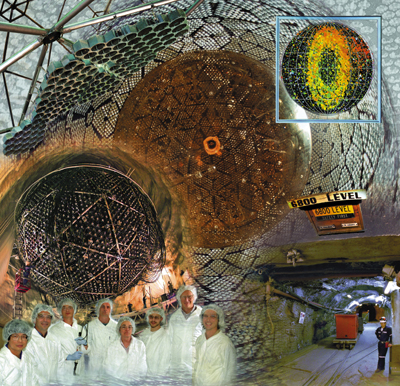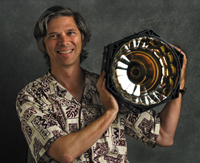|
|
 |
|
| |
 |
 |
|
| |
|
| Kevin Lesko, a physicist who leads the
Neutrino Astrophysics Group for Berkeley Lab's Nuclear
Science Division, poses with a single photomultiplier
tube from the Sudbury Neutrino Observatory (SNO), a unique
telescope located more than a mile underground to study
the elusive neutrino. |
|
| |
|
Berkeley Lab researchers were part of an international team
of scientific sleuths that cracked the case through the use
of the Sudbury Neutrino Observatory (SNO), a unique type of
telescope located more than a mile underground in Canada.
Two years of investigation yielded "unambiguous evidence"
that most solar neutrinos undergo a metamorphosis during their
93-million-mile journey to Earth, changing from one type or,
as physicists say, "flavor," to another.
These results contradict the predictions of the Standard Model,
the bedrock theory upon which rests the current scientific
understanding of the fundamental particles and forces of nature,
but they definitively answer a question that has puzzled scientists
for nearly three decades.
"Because these results are derived from a single experiment,
they do not involve the complications of combining other experiments'
results," said Kevin Lesko, a physicist who leads the
Neutrino Astrophysics Group for the Berkeley Lab's Nuclear
Science Division (NSD). "As a consequence, our evidence
is so very strong that it is 99.999 percent certain that SNO
has seen a flavor change in neutrinos."
In June of 2001, the SNO collaborators reported results from
their first year of investigation that, in combination with
experimental data from a neutrino detector in Japan, the Super-Kamiokande,
strongly pointed to neutrinos switching their flavor on their
way here from the sun. This second year's worth of data should
erase any lingering doubts.
According to the Standard Model, neutrinos come in three flavors--electron,
muon and tau neutrinos. Electron neutrinos are by far the
most common and are produced within the core of the sun (and
in supernovae) at the rate of more than two hundred trillion
trillion every second. For more than 30 years, experimenters
have measured far fewer solar neutrinos than they should have
detected based on what is known about thermonuclear reactions.
However, the rules of neutrino observation have been substantially
upgraded with the arrival of SNO, which is the first neutrino
telescope sensitive enough to simultaneously measure all three
neutrino flavors.
|
| "Two years
of investigation yielded "unambiguous evidence"
that most solar neutrinos undergo a metamorphosis during
their 93-million-mile journey to Earth." |
|
Operating out of a nickel mine near Sudbury, in the Canadian
province of Ontario, SNO consists of an 18-meter-diameter,
58,000-pound stainless steel geodesic sphere suspended in
a pool filled with 7,000 tons of purified water. Inside this
sphere is an acrylic vessel filled with 1,000 tons of heavy
water (deuterium oxide or D2O). Attached to the sphere are
9,456 ultrasensitive light sensors called photomultiplier
tubes. When neutrinos passing through the heavy water interact
with deuterium nuclei, flashes of light, called Cerenkov radiation,
are emitted. The photomultiplier tubes detect these light
flashes and convert them into electronic signals that scientists
can analyze.
In a press release announcing the results from the second
year of investigation, Art McDonald of Queen's University,
director of the SNO research team, a collaboration of close
to 100 scientists at 11 universities and national laboratories
in Canada, the United States, and the United Kingdom, declared
the case of the missing solar neutrinos to be closed.
"While the number of electron neutrinos we detected is
only about one-third the number expected, the total number
of the three types of neutrinos we observe is in excellent
agreement with calculations of the nuclear reactions powering
the sun," McDonald said. "The SNO team is very pleased
with the quality of the data obtained and really excited because
our measurements enable neutrino properties to be defined
with much greater certainty in fundamental theories of elementary
particles."
The fact that neutrinos are changing flavor during their journey
means they have must have mass, even though it is very small.
This again runs contrary to Standard Model predictions.
Says Lesko, "The Standard Model needs to be expanded
to embrace neutrino mass and mixing. This is a challenge,
and one that will take some time."
In addition to Lesko, other members of the Neutrino Astrophysics
Group at Berkeley Lab who contributed to the latest SNO results
include physicists Bob Stokstad, Eric Norman, Yuen-dat Chan,
and Alan Poon, plus post-docs Colin Okada and Xin Chen, graduate
students Alysia Marino of UC Berkeley and Sarah Rosendahl
from Sweden, and undergraduate students Kathy Opachich of
UC Berkeley and Noah Oblath from Cornell University. To run
their data analysis, the SNO collaboration made extensive
use of the supercomputing facilities at the National Energy
Research Scientific Computing Center (NERSC), which is hosted
by Berkeley Lab.
-- Lynn Yarris
|
 |



